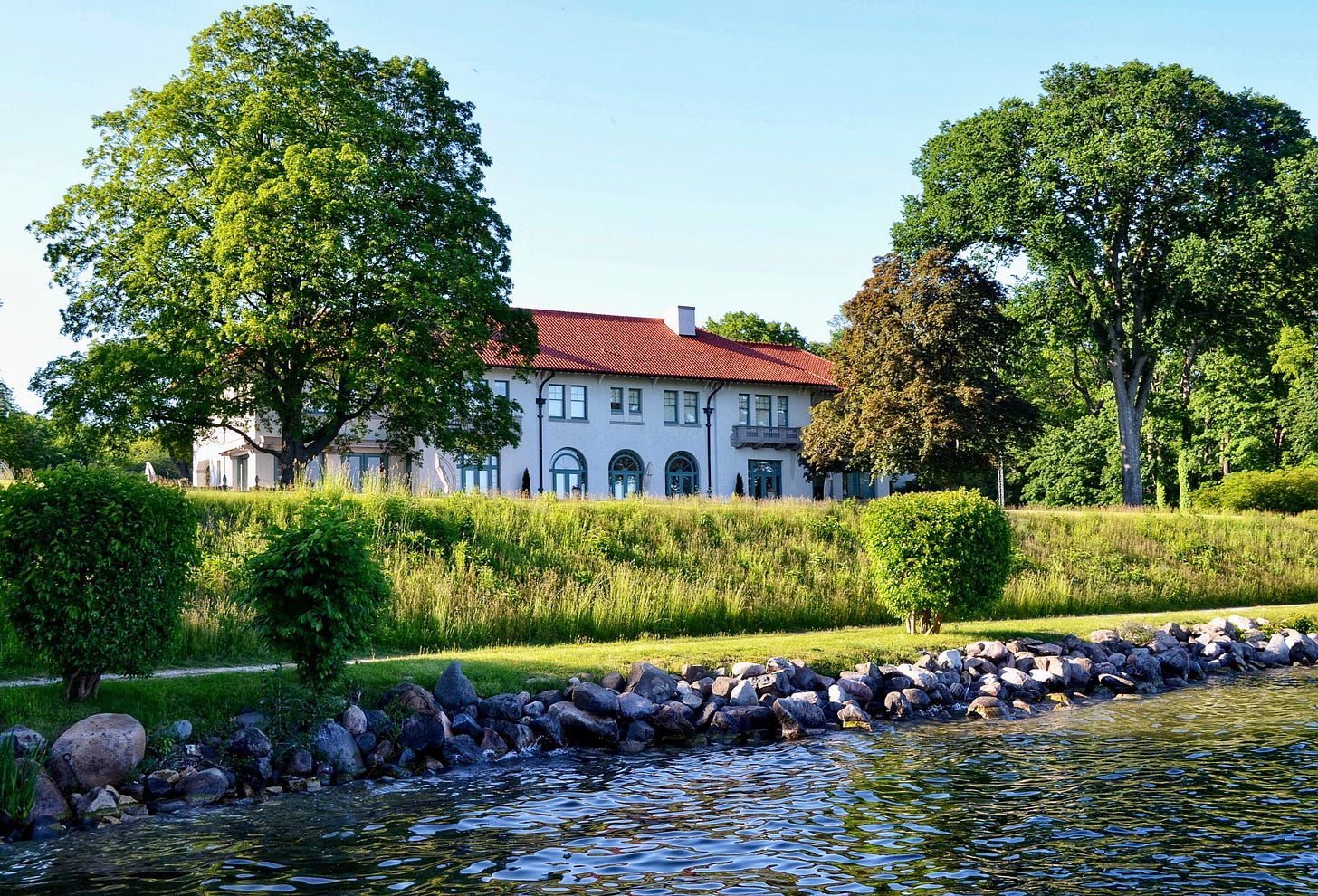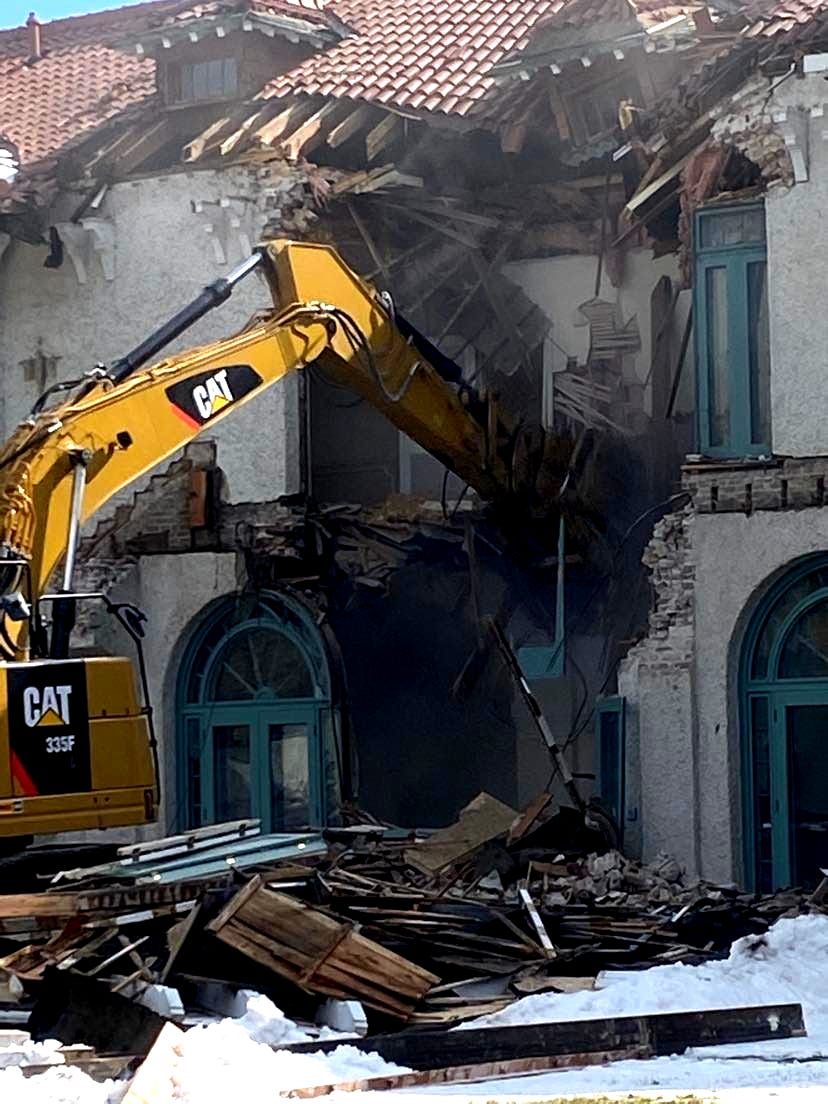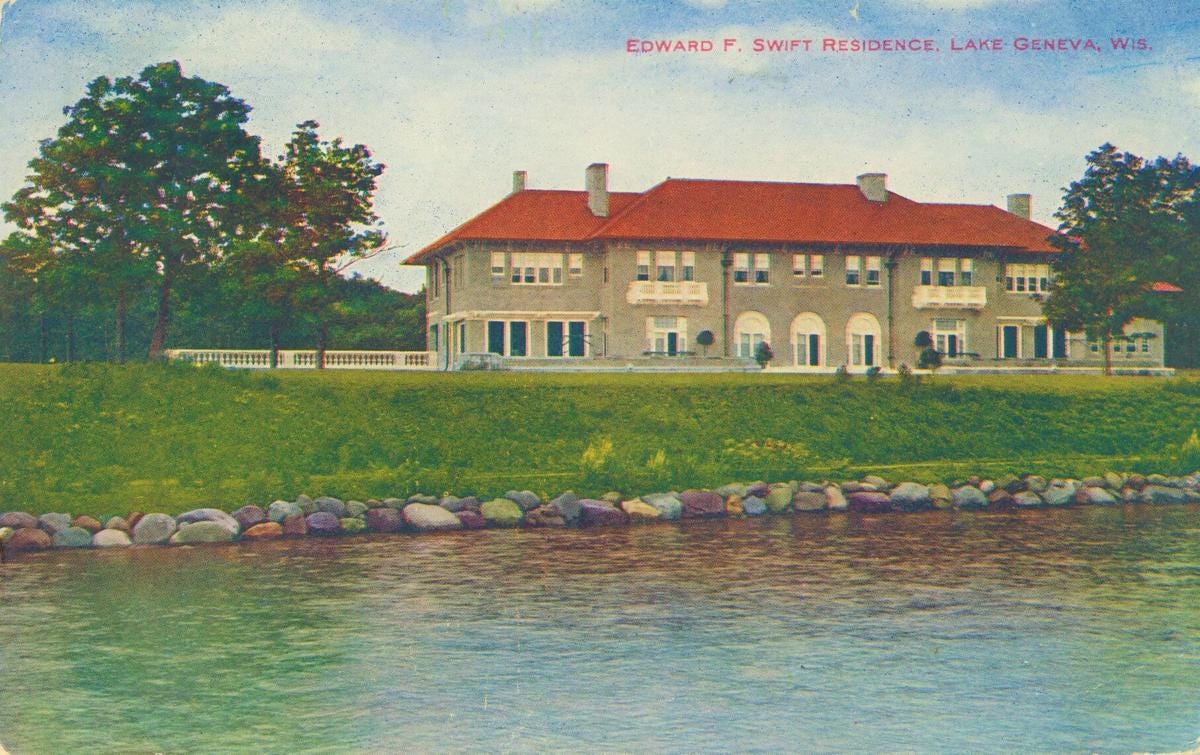
I’m fully aware this substack is supposed to be about the architecture of Chicagoland. But if there is such a thing as a Chicago “North,” then it would have to be the shores of Geneva Lake in Wisconsin. Once called the “Newport of the West,” Geneva was first connected to Chicago starting in 1856 with daily trains on the Wisconsin Central Railroad. It took off as a vacation spot for wealthy Chicagoans beginning in the 1870s with early travelers stepping right off the rail platform to boat docks. Dozens of elegant yachts and steamers would take families with names like Wacker, Selfridge, and Seipp directly to their lakeshore residences. While many of those old mansions disappeared along the shoreline through the decades, there are a handful that have survived. Villa Hortensia, a twenty plus acre property that came with over 500 feet of lake frontage, was one of them until its demolition in early March.
The historic estate sold last October for $17 million, making it the second highest sale ever on Geneva Lake after its next-door neighbor Glanworth Gardens (and former home of the late Chicago philanthropist Richard Driehaus) sold in early 2022 for $36 million. Ralph and Sally MacDonald had bought it 25 years ago, becoming the eighth and final owners of what had once been called the “Jewel in the Geneva Lake Crown.” I have spent significant time in this area (no, I do own a home here…I wish) so I know the small town likes to gossip. Rumors quickly escalated that this pricey property could be razed and the land subdivided. Back in December a local resident shared that a Lowell Custom Homes sign had been put up near the road entrance to the home. No surprise at all that hearsay became literal fact.

Architect Howard Van Doren Shaw, a leader in the American Arts & Crafts movement, designed this summer home for Chicago meatpacking tycoon Edward Swift in 1906 who named it after his wife Hortense. That was the same year Shaw’s only skyscraper was built, the Mentor Building, which still stands at State and Monroe in Chicago’s Loop. Fellow architect Thomas Tallmadge described Shaw as “the most rebellious of the conservatives, and the most conservative of the rebels.” From his own travels to Great Britain where he sketched numerous buildings, Shaw’s domestic work drew heavily from contemporary English architecture, which also happened to overlap with what was taking place in his own backyard, Chicago designs like the Prairie School. Architectural historian Carl W. Condit called Shaw, a resident of Lake Forest who’d been educated at Yale and MIT, “an architect of unusual talents.”
The stucco-clad Mediterranean-styled forty-room mansion with Arts & Crafts details and prominent red clay tile roof was located off picturesque Snake Road. It came with a guest house, boat house, and outdoor swimming pool. While Shaw connected the interior with the outside landscape, he also repeated sets of threes throughout the design: three arched openings with Doric columns on the covered entry porch, three repeated glass French doors, the three arches in the drawing room. In his book Inventing the American House, architect Stuart Cohen suggests the details of Villa Hortensia foreshadow 1920s bungalows, though on a grander scale. It also reminds me of another Shaw-designed home located on Orrington Avenue in Evanston, the Carl E. Williams residence from 1909. But let’s get back to the original owner.

Edward was one of eleven children born to Gustavus Swift, credited with the development of the first practical ice-cooled railroad car who once bragged that his slaughterhouses in Chicago’s Union Stock Yards used "everything but the squeal." When he died in 1903, Swift & Company was valued at $135 million. Edward, vice-president of Swift and director of its numerous associated companies, was the first member of the family to hire architect Howard Van Doren Shaw to design a house. A guest suite was included in its to design for Edward’s numerous siblings and their families, including Louis, Helen, and Gustavus Jr. The estate was sold by the Swifts in November 1921. George Getz took ownership of Villa Hortensia in the late 1940s. His wife, Olivia Atwater, was the sister of Helen, Philip K. Wrigley’s wife. (Got that straight?) The Wrigleys are probably one of the best known families to live along the lake. A decade after selling his summer retreat Edward Swift accidentally fell to his death from the eighth story window of his apartment at 1550 North State Parkway in Chicago’s Gold Coast in 1932. He left an $8 million estate to his widow Hortense, who passed away at their home three years later.

Whether it’s a greedy developer who wants to build a bunch of residences on the valuable piece of land or a new owner who wants to put up a new ostentatious mansion to display their wealth, what I find most appalling is the waste of it all. There appears to have been no attempt to save or reuse anything from the home in an environmentally responsible manner. It was just bulldozed with all that fine craftsmanship and architectural detail to end up in a landfill. I know the house was not well maintained by its last owner but it could have been restored and repurposed in so many ways. The saddest part is this probably won’t be the last historic home on Geneva Lake that will be lost to new construction. Glen Arden, Maple Lawn, and Oak Lodge are the most recent examples. Should there be a steep tax on destroying historic, artisanal architecture? In my personal opinion, yes…yes…YES!

A few years ago an old home known as Six Oaks/Swinghurst was torn down. Built in 1883, this wonderful surviving example of a multi-gabled Queen Anne style design had an exterior balcony added to the third floor by its original owner, David Swing, a popular Chicago preacher who delivered sermons to the large crowds that gathered on his lawn. Sunken tubs inside, which survived until the bitter end, were used for baptisms. Dr. Swing, who is credited with giving Lake Geneva its “Newport of the West” title, was pastor of Chicago’s Westminster Presbyterian Church (after 1868 it became the Fourth Presbyterian Church) starting in 1866. He then went on to preach regularly from the stage at McVickers Theater, always drawing a big audience. His Lake Geneva retreat stayed in the family until the 1930s. Swinghurst was last owned by Marie Kropp who lived here with her husband, legendary comedian Dick Smothers. It was sold it in 2017 after the couple moved permanently to the Sarasota area.
Lake Geneva loves to discuss and sell its history to the many tourists who pack the town every summer. But at the same time does nothing to protect it. One can argue “People are allowed to do what they want with their own property.” Yet we live in a communal world where rich individuals’ actions impact the community at large. The non-wealthy should have a say in what happens around them, not just some property owner with deep pockets. The countless boat tours going up and down the lakeshore show the positive impact the area’s history has on the public. These unnecessary demolitions have been going on for literal decades. The Schwinn Mansion near Williams Bay. Loramoor, once the largest estate in the area with 32 buildings (only a handful survive today). It’s always about the money. Greed rules. Nothing is sacred on the lake.
ETA: Right after I published this post, the Chicago Tribune revealed in a new article the mystery buyer’s identity - it turns out the new owner of Villa Hortensia is James Conlon of St. Charles. “[He] sold his Elite Manufacturing Technologies company, which makes cabinets, consoles and assemblies for the electronic gaming industry, to a private equity firm for an undisclosed amount.” (Yeah, I can just guess for how much.) The property is zoned for three dwellings so that’s what Lowell Custom Homes will be constructing for Conlon as part of a new family compound. Ugh.
Sources:
Geneva Lake: Stories From The Shore edited by Anne Celano Frohna
Inventing the American House by Stuart Cohen
Creating Chicago’s North Shore by Michael E. Ebner






Not horrible waste at all. If it were cost effective to renovate the old home it would have been done. It was deemed uninhabitable and was infested with mold. The new owner has removed fixtures and items of historical significance and will be donating some of these to the historical museum. Everything has a use life, including houses.
Horrible waste of a beautiful, historic home. Very, very sad and, yes, I wholeheartedly agree that Lake Geneva needs to step up and pass laws to protect these prestigious, historic homes! Not to mention holding owners and contractors accountable for repurposing materials from homes that are demolished. Shame on Lake Geneva for not doing the right thing for historic homes and the environment!!!